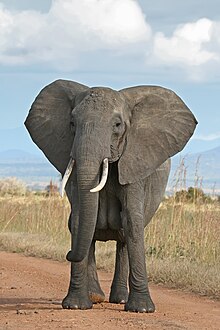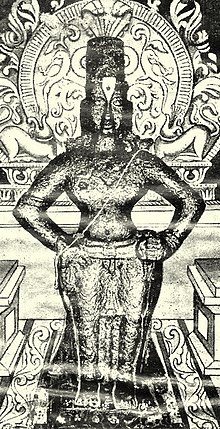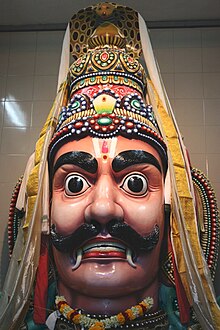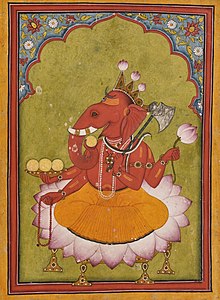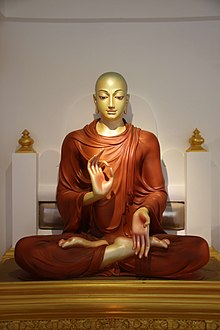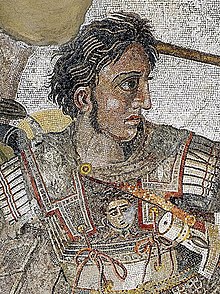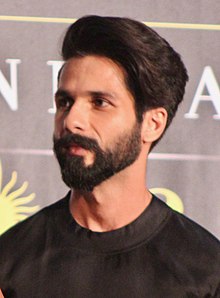Portal:India
Portal maintenance status: (June 2018)
|
Introduction

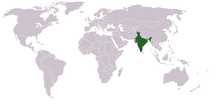
India, officially the Republic of India (ISO: Bhārat Gaṇarājya), is a country in South Asia. It is the seventh-largest country by area; the most populous country as of June 2023; and from the time of its independence in 1947, the world's most populous democracy. Bounded by the Indian Ocean on the south, the Arabian Sea on the southwest, and the Bay of Bengal on the southeast, it shares land borders with Pakistan to the west; China, Nepal, and Bhutan to the north; and Bangladesh and Myanmar to the east. In the Indian Ocean, India is in the vicinity of Sri Lanka and the Maldives; its Andaman and Nicobar Islands share a maritime border with Thailand, Myanmar, and Indonesia. (Full article...)
 Featured article – show another
Featured article – show another
-
Image 1Mother India is a 1957 Indian epic drama film, directed by Mehboob Khan and starring Nargis, Sunil Dutt, Rajendra Kumar and Raaj Kumar. A remake of Khan's earlier film Aurat (1940), it is the story of a poverty-stricken village woman named Radha (Nargis), who in the absence of her husband, struggles to raise her sons and survive against a cunning money-lender amidst many troubles.
The title of the film was chosen to counter American author Katherine Mayo's 1927 polemical book Mother India, which vilified Indian culture. Mother India metaphorically represents India as a nation in the aftermath of its independence in 1947, and alludes to a strong sense of Indian nationalism and nation-building. Allusions to Hindu mythology are abundant in the film, and its lead character has been seen as a metonymic representation of an Indian woman who reflects high moral values and the concept of what it means to be a mother to society through self-sacrifice. While some authors treat Radha as the symbol of women's empowerment, others see her cast in female stereotypes. The film was shot in Mumbai's Mehboob Studios and in the villages of Maharashtra, Gujarat, and Uttar Pradesh. The music by Naushad introduced global music, including Western classical music and orchestra, to Hindi cinema. (Full article...) -
Image 2Chandralekha (also spelt Chandraleka) is a 1948 Indian historical adventure film produced and directed by S. S. Vasan of Gemini Studios. Starring T. R. Rajakumari, M. K. Radha and Ranjan, the film follows two brothers (Veerasimhan and Sasankan) who fight over ruling their father's kingdom and marrying a village dancer, Chandralekha.
Development began during the early 1940s when, after two successive box-office hits, Vasan announced that his next film would be entitled Chandralekha. However, when he launched an advertising campaign for the film he only had the name of the heroine from a storyline he had rejected. Veppathur Kittoo (one of Vasan's storyboard artists) developed a story based on a chapter of George W. M. Reynolds' novel, Robert Macaire: or, The French bandit in England. Original director T. G. Raghavachari left the film more than halfway through because of disagreements with Vasan, who took over in his directorial debut. (Full article...) -
Image 3Osbert Guy Stanhope Crawford CBE FBA FSA (28 October 1886 – 28 November 1957) was a British archaeologist who specialised in the archaeology of prehistoric Britain and Sudan. A keen proponent of aerial archaeology, he spent most of his career as the archaeological officer of the Ordnance Survey (OS) and also wrote a range of books on archaeological subjects.
Born in Bombay, British India, to a wealthy middle-class Scottish family, Crawford moved to England as an infant and was raised by his aunts in London and Hampshire. He studied geography at Keble College, Oxford, and worked briefly in that field before devoting himself professionally to archaeology. Employed by the philanthropist Henry Wellcome, Crawford oversaw the excavation of Abu Geili in Sudan before returning to England shortly before the First World War. During the conflict he served in both the London Scottish Regiment and the Royal Flying Corps, where he was involved in ground and aerial reconnaissance along the Western Front. After an injury forced a period of convalescence in England, he returned to the Western Front, where he was captured by the German Army in 1918 and held as a prisoner of war until the end of the conflict. (Full article...) -
Image 4
Dimple Kapadia (born 8 June 1957) is an Indian actress predominantly appearing in Hindi films. Born and raised in Mumbai by wealthy parents, she aspired to become an actress from a young age and received her first opportunity through her father's efforts to launch her in the film industry. She was discovered at age 14 by the filmmaker Raj Kapoor, who cast her in the title role of his teen romance Bobby (1973), which opened to major commercial success and gained her wide public recognition. Shortly before the film's release in 1973, she married the actor Rajesh Khanna and quit acting. Their daughters, Twinkle and Rinke Khanna, both briefly worked as actresses in their youth. Kapadia returned to films in 1984, two years after her separation from Khanna. Her comeback film Saagar, which was released a year later, revived her career. Both Bobby and Saagar won her Filmfare Awards for Best Actress. Through her work over the next decade, she established herself as one of Hindi cinema's leading actresses.
While her initial roles often relied on her perceived beauty and sex appeal, Kapadia was keen to challenge herself and expand her range. She was among the first actresses who starred in women-centred Hindi action films but found greater favour with critics when she took on more dramatic roles in both mainstream and neorealist parallel cinema. Appearing in films ranging from marital dramas to literary adaptations, she played troubled women sometimes deemed reflective of her personal experience, and received acclaim for her performances in Kaash (1987), Drishti (1990), Lekin... (1991), and Rudaali (1993). For her role as a professional mourner in Rudaali, she won the National Film Award for Best Actress and a Filmfare Critics Award. She also had supporting roles in the crime dramas Prahaar (1991), Angaar (1992), Gardish (1993) and Krantiveer (1994), the latter securing her another Filmfare Award. (Full article...) -
Image 5Portrait by Charles Dana Gibson, c. 1903
Margaret Ives Abbott (June 15, 1878 – June 10, 1955) was an American amateur golfer. She was the first American woman to win an Olympic event: the women's golf tournament at the 1900 Summer Olympics.
Born in Calcutta (now Kolkata), British Raj, in 1878, Abbott moved with her family to Chicago in 1884. She joined the Chicago Golf Club in Wheaton, Illinois, where she received coaching from Charles B. Macdonald and H. J. Whigham. In 1899, she traveled with her mother to Paris to study art. The following year, along with her mother, she signed up for a women's golf tournament without realizing that it was the second modern Olympics. Abbott won the tournament with a score of 47 strokes; her mother tied for seventh place. Abbott received a porcelain bowl as a prize. (Full article...) -
Image 6Padukone at the 2018 Cannes Film Festival
Deepika Padukone (pronounced [d̪iːpɪkaː pəɖʊkoːɳeː]; born 5 January 1986) is an Indian actress who works predominantly in Hindi films. She is India's highest-paid actress, as of 2023, and her accolades include three Filmfare Awards. She features in listings of the nation's most popular personalities; Time named her one of the 100 most influential people in the world in 2018 and awarded her the Time100 Impact Award in 2022.
Padukone, the daughter of the badminton player Prakash Padukone, was born in Copenhagen and raised in Bangalore. As a teenager, she played badminton in national level championships but left her career in the sport to become a fashion model. She soon received offers for film roles and made her acting debut in 2006 as the title character of the Kannada film Aishwarya. Padukone then played a dual role opposite Shah Rukh Khan in her first Bollywood release, the romance Om Shanti Om (2007), which won her the Filmfare Award for Best Female Debut. Padukone received praise for her starring role in the romance Love Aaj Kal (2009), but this was followed by a brief setback. (Full article...) -
Image 7
Kaikhosru Shapurji Sorabji (born Leon Dudley Sorabji; 14 August 1892 – 15 October 1988) was an English composer, music critic, pianist and writer whose music, written over a period of seventy years, ranges from sets of miniatures to works lasting several hours. One of the most prolific 20th-century composers, he is best known for his piano pieces, notably nocturnes such as Gulistān and Villa Tasca, and large-scale, technically intricate compositions, which include seven symphonies for piano solo, four toccatas, Sequentia cyclica and 100 Transcendental Studies. He felt alienated from English society by reason of his homosexuality and mixed ancestry, and had a lifelong tendency to seclusion.
Sorabji was educated privately. His mother was English and his father a Parsi businessman and industrialist from India, who set up a trust fund that freed his family from the need to work. Although Sorabji was a reluctant performer and not a virtuoso, he played some of his music publicly between 1920 and 1936. In the late 1930s, his attitude shifted and he imposed restrictions on performance of his works, which he lifted in 1976. His compositions received little exposure in those years and he remained in public view mainly through his writings, which include the books Around Music and Mi contra fa: The Immoralisings of a Machiavellian Musician. During this time, he also left London and eventually settled in the village of Corfe Castle, Dorset. Information on Sorabji's life, especially his later years, is scarce, with most of it coming from the letters he exchanged with his friends. (Full article...) -
Image 8A female African bush elephant in Mikumi National Park, Tanzania
Elephants are the largest living land animals. Three living species are currently recognised: the African bush elephant (Loxodonta africana), the African forest elephant (L. cyclotis), and the Asian elephant (Elephas maximus). They are the only surviving members of the family Elephantidae and the order Proboscidea; extinct relatives include mammoths and mastodons. Distinctive features of elephants include a long proboscis called a trunk, tusks, large ear flaps, pillar-like legs, and tough but sensitive grey skin. The trunk is prehensile, bringing food and water to the mouth and grasping objects. Tusks, which are derived from the incisor teeth, serve both as weapons and as tools for moving objects and digging. The large ear flaps assist in maintaining a constant body temperature as well as in communication. African elephants have larger ears and concave backs, whereas Asian elephants have smaller ears and convex or level backs.
Elephants are scattered throughout sub-Saharan Africa, South Asia, and Southeast Asia and are found in different habitats, including savannahs, forests, deserts, and marshes. They are herbivorous, and they stay near water when it is accessible. They are considered to be keystone species, due to their impact on their environments. Elephants have a fission–fusion society, in which multiple family groups come together to socialise. Females (cows) tend to live in family groups, which can consist of one female with her calves or several related females with offspring. The leader of a female group, usually the oldest cow, is known as the matriarch. (Full article...) -
Image 9
Arthur Edward Jeune Collins (18 August 1885 – 11 November 1914) was an English cricketer and soldier. He held, for 116 years, the record of highest score in cricket: as a 13-year-old schoolboy, he scored 628 not out over four afternoons in June 1899. Collins's record-making innings drew a large crowd and increasing media interest; spectators at the Old Cliftonian match being played nearby were drawn away to watch the junior school house cricket match in which Collins was playing. Despite this achievement, Collins never played first-class cricket. Collins's 628 not out stood as the record score until January 2016 when an Indian boy, Pranav Dhanawade, scored 1009 in a single innings.
Collins joined the British Army in 1902 and studied at the Royal Military Academy, Woolwich, before becoming an officer in the Royal Engineers. He served in France during the First World War, where he was killed in action in 1914 during the First Battle of Ypres. Collins had been mentioned in despatches and also represented the Royal Military Academy at cricket and rugby union. (Full article...) -
Image 10Mughal-e-Azam (transl. The Great Mughal) is a 1960 Indian epic historical drama film produced and directed by K. Asif. Starring Prithviraj Kapoor, Dilip Kumar, Madhubala, and Durga Khote, it follows the love affair between Mughal Prince Salim (who went on to become Emperor Jahangir) and Anarkali, a court dancer. Salim's father, Emperor Akbar, disapproves of the relationship, which leads to a war between father and son.
The development of Mughal-e-Azam began in 1944, when Asif read a 1922 play called Anarkali, by the playwright Imtiaz Ali Taj, which is set in the reign of Emperor Akbar (1556–1605). Production was plagued by delays and financial uncertainty. Before its principal photography began in the early 1950s, the project had lost a financier and undergone a complete change of cast. Mughal-e-Azam cost more to produce than any previous Indian motion picture; the budget for a single song sequence exceeded that typical for an entire film of the period. The soundtrack, inspired by Indian classical and folk music, comprises 12 songs voiced by playback singer Lata Mangeshkar along with Mohammed Rafi, Shamshad Begum and classical singer Bade Ghulam Ali Khan, and is often cited among the finest in the history of Hindi cinema. (Full article...) -
Image 11
Tiruchirappalli (Tamil pronunciation: [ˈt̪iɾɯtːʃiɾaːpːaɭːi] ⓘ, formerly Trichinopoly in English), also called Tiruchi or Trichy, is a major tier II city in the Indian state of Tamil Nadu and the administrative headquarters of Tiruchirappalli district. The city is credited with being the best livable city, the cleanest city of Tamil Nadu, as well as the fifth safest city for women in India. It is the fourth largest city as well as the fourth largest urban agglomeration in the state. Located 322 kilometres (200 mi) south of Chennai and 374 kilometres (232 mi) north of Kanyakumari, Tiruchirappalli sits almost at the geographic centre of Tamil Nadu state. The Cauvery Delta begins 16 kilometres (9.9 mi) west of the city where the Kaveri river splits into two, forming the island of Srirangam which is now incorporated into the Tiruchirappalli City Municipal Corporation. The city occupies an area of 167.23 square kilometres (64.57 sq mi) and had a population of 916,857 in 2011.
Tiruchirappalli's recorded history begins in the 3rd century BC, when it was under the rule of the Cholas. The city has also been ruled by the Mutharaiyars, Pallavas, Pandyas, Vijayanagar Empire, Nayak Dynasty, the Carnatic state and the British. The most prominent historical monuments in Tiruchirappalli include the Rockfort at Teppakulam, the Ranganathaswamy temple at Srirangam dedicated to the reclining form of Hindu God Vishnu, and is also the largest functioning temple in the world, and the Jambukeswarar temple at Thiruvanaikaval, which is also the largest temple for the Hindu God Shiva in the world. The archaeologically important town of Uraiyur, capital of the Early Cholas, is now a neighbourhood in Tiruchirappalli. The city played a critical role in the Carnatic Wars (1746–1763) between the British and the French East India companies. (Full article...) -
Image 12Ahalya by Raja Ravi Varma (1848–1906)
In Hinduism, Ahalya (Sanskrit: अहल्या, IAST: Ahalyā) also spelt as Ahilya, is the wife of the sage Gautama Maharishi. Many Hindu scriptures describe her legend of seduction by the king of the gods Indra, her husband's curse for her infidelity, and her liberation from the curse by the god Rama.
Created by the god Brahma as the most beautiful woman, Ahalya was married to the much older Gautama. In the earliest full narrative, when Indra comes disguised as her husband, Ahalya sees through his disguise but nevertheless accepts his advances. Later sources often absolve her of all guilt, describing how she falls prey to Indra's trickery. In all narratives, Ahalya and Indra are cursed by Gautama. The curse varies from text to text, but almost all versions describe Rama as the eventual agent of her liberation and redemption. Although early texts describe how Ahalya must atone by undergoing severe penance while remaining invisible to the world and how she is purified by offering Rama hospitality, in the popular retelling developed over time, Ahalya is cursed to become a stone and regains her human form after she is brushed by Rama's foot. (Full article...) -
Image 13Kal Ho Naa Ho (transl. There may be no tomorrow, pronounced [kəl ɦoː naː ɦoː]), also abbreviated as KHNH, is a 2003 Indian Hindi-language romantic drama film directed by Nikhil Advani in his directorial debut with a story written by Karan Johar with dialogue by Niranjan Iyengar, and produced by Yash Johar. The film stars Jaya Bachchan, Shah Rukh Khan, Saif Ali Khan, and Preity Zinta, with Sushma Seth, Reema Lagoo, Lillete Dubey, and Delnaaz Irani in supporting roles. In the film, Naina Catherine Kapur (Zinta) and Aman Mathur (Shah Rukh Khan) fall in love, but a secret prevents him from reciprocating his feelings and results in a plan to set Naina up with her best friend, Rohit Patel (Saif Ali Khan).
Collaborating with Johar, Shankar–Ehsaan–Loy composed the soundtrack and score. Anil Mehta, Manish Malhotra, and Sharmishta Roy were the cinematographer, costume designer and art director, respectively. Principal photography took place in Toronto, New York City, and Mumbai from January to October 2003. The soundtrack was released on 27 September 2003 to positive reviews; the title song, "It's The Time To Disco", "Kuch To Hua Hai", and "Pretty Woman" were particularly well-received. (Full article...) -
Image 14
Kareena Kapoor Khan (pronounced [kəˈriːna kəˈpuːr xɑːn]; née Kapoor; born 21 September 1980) is an Indian actress. A prolific leading lady of Hindi cinema since 2000, she is noted for playing a variety of roles in a range of film genres—from romantic comedies to crime dramas. Kapoor is the recipient of several awards, including six Filmfare Awards, and is one of India's highest-paid actresses.
Born into the Kapoor family, she is the daughter of actors Babita and Randhir Kapoor, and the younger sister of actress Karisma Kapoor. After making her acting debut in 2000 in Refugee, Kapoor established herself the following year with several roles, including in the top-grossing drama Kabhi Khushi Kabhie Gham.... This was followed by a series of commercial failures and negative reviews for her repetitive roles. An against-type performance as a sex worker in the 2004 drama Chameli marked a turning point in her career. She earned critical recognition for her portrayal of a riot victim in the 2004 drama Dev and a character based on Desdemona in the 2006 crime film Omkara. Her performance as a loquacious woman in the romantic comedy Jab We Met (2007) earned her the Filmfare Award for Best Actress. (Full article...) -
Image 15Sir Robert Eric Mortimer Wheeler CH CIE MC TD FRS FBA FSA (10 September 1890 – 22 July 1976) was a British archaeologist and officer in the British Army. Over the course of his career, he served as Director of both the National Museum of Wales and London Museum, Director-General of the Archaeological Survey of India, and the founder and Honorary Director of the Institute of Archaeology in London, in addition to writing twenty-four books on archaeological subjects.
Born in Glasgow to a middle-class family, Wheeler was raised largely in Yorkshire before moving to London in his teenage years. After studying classics at University College London (UCL), he began working professionally in archaeology, specialising in the Romano-British period. During World War I he volunteered for service in the Royal Artillery, being stationed on the Western Front, where he rose to the rank of major and was awarded the Military Cross. Returning to Britain, he obtained his doctorate from UCL before taking on a position at the National Museum of Wales, first as Keeper of Archaeology and then as Director, during which time he oversaw excavation at the Roman forts of Segontium, Y Gaer, and Isca Augusta with the aid of his first wife, Tessa Wheeler. Influenced by the archaeologist Augustus Pitt Rivers, Wheeler argued that excavation and the recording of stratigraphic context required an increasingly scientific and methodical approach, developing the "Wheeler method". In 1926, he was appointed Keeper of the London Museum; there, he oversaw a reorganisation of the collection, successfully lobbied for increased funding, and began lecturing at UCL. (Full article...) -
Image 16

India, officially the Republic of India (ISO: Bhārat Gaṇarājya), is a country in South Asia. It is the seventh-largest country by area; the most populous country as of June 2023; and from the time of its independence in 1947, the world's most populous democracy. Bounded by the Indian Ocean on the south, the Arabian Sea on the southwest, and the Bay of Bengal on the southeast, it shares land borders with Pakistan to the west; China, Nepal, and Bhutan to the north; and Bangladesh and Myanmar to the east. In the Indian Ocean, India is in the vicinity of Sri Lanka and the Maldives; its Andaman and Nicobar Islands share a maritime border with Thailand, Myanmar, and Indonesia.
Modern humans arrived on the Indian subcontinent from Africa no later than 55,000 years ago.
Their long occupation, initially in varying forms of isolation as hunter-gatherers, has made the region highly diverse, second only to Africa in human genetic diversity. Settled life emerged on the subcontinent in the western margins of the Indus river basin 9,000 years ago, evolving gradually into the Indus Valley Civilisation of the third millennium BCE.
Between 2000 BCE and 1500 BCE, Indo-Aryans migrated into India from the northwest, bringing with them Sanskrit, an Indo-European language. Its evidence today is found in the hymns of the Rigveda. Preserved by an oral tradition that was resolutely vigilant, the Rigveda records the dawning of Hinduism in India. The Dravidian languages of India were supplanted in the northern and western regions.
By 400 BCE, stratification and exclusion by caste had emerged within Hinduism,
and Buddhism and Jainism had arisen, proclaiming social orders unlinked to heredity.
Early political consolidations gave rise to the loose-knit Maurya and Gupta Empires based in the Ganges Basin.
Their collective era was suffused with wide-ranging creativity, but also marked by the declining status of women, and the incorporation of untouchability into an organised system of belief. In South India, the Middle kingdoms exported Dravidian-languages scripts and religious cultures to the kingdoms of Southeast Asia. (Full article...) -
Image 17Keechaka Vadham (transl. The Extermination of Keechaka) is an Indian silent film produced, directed, filmed and edited by R. Nataraja Mudaliar. The first film to have been made in South India, it was shot in five weeks at Nataraja Mudaliar's production house, India Film Company. As the members of the cast were Tamils, Keechaka Vadham is considered to be the first Tamil film. No print of it is known to have survived, making it a lost film.
The screenplay, written by C. Rangavadivelu, is based on an episode from the Virata Parva segment of the Hindu epic Mahabharata, focusing on Keechaka's attempts to woo Draupadi. The film stars Raju Mudaliar and Jeevarathnam as the central characters. (Full article...) -
Image 18

The Chalukya dynasty ([tʃaːɭukjə]) was a Classical Indian dynasty that ruled large parts of southern and central India between the 6th and the 12th centuries. During this period, they ruled as three related yet individual dynasties. The earliest dynasty, known as the "Badami Chalukyas", ruled from Vatapi (modern Badami) from the middle of the 6th century. The Badami Chalukyas began to assert their independence at the decline of the Kadamba kingdom of Banavasi and rapidly rose to prominence during the reign of Pulakeshin II. After the death of Pulakeshin II, the Eastern Chalukyas became an independent kingdom in the eastern Deccan. They ruled from Vengi until about the 11th century. In the western Deccan, the rise of the Rashtrakutas in the middle of the 8th century eclipsed the Chalukyas of Badami before being revived by their descendants, the Western Chalukyas, in the late 10th century. These Western Chalukyas ruled from Kalyani (modern Basavakalyan) until the end of the 12th century.
The rule of the Chalukyas marks an important milestone in the history of South India and a golden age in the history of Karnataka. The political atmosphere in South India shifted from smaller kingdoms to large empires with the ascendancy of Badami Chalukyas. A Southern India-based kingdom took control and consolidated the entire region between the Kaveri and the Narmada rivers. The rise of this empire saw the birth of efficient administration, overseas trade and commerce and the development of new style of architecture called "Chalukyan architecture". Kannada literature, which had enjoyed royal support in the 9th century Rashtrakuta court found eager patronage from the Western Chalukyas in the Jain and Veerashaiva traditions. The 11th century saw the patronage of Telugu literature under the Eastern Chalukyas. (Full article...) -
Image 19The central image at Vithoba Temple in Pandharpur
Vithoba (IAST: Viṭhobā), also known as Vitthala (IAST: Viṭṭhala), and Panduranga (IAST: Pāṇḍuraṅga), is a Hindu deity predominantly worshipped in the Indian state of Maharashtra and Karnataka. He is a form of the Hindu deity Vishnu in his avatar: Krishna. Vithoba is often depicted as a dark young boy, standing arms akimbo on a brick, sometimes accompanied by his consort Rakhumai.
Vithoba is the focus of an essentially monotheistic, non-ritualistic bhakti-driven Varkari faith in Maharashtra and the Brahminical Haridasa sect established in Dvaita Vedanta in Karnataka. Vithoba Temple, Pandharpur is his main temple. Vithoba legends revolve around his devotee Pundalik who is credited for bringing the deity to Pandharpur, and around Vithoba's role as a saviour to the poet-saints of the Varkari faith. The Varkari poet-saints are known for their unique genre of devotional lyric, the abhang, dedicated to Vithoba and composed in Marathi. Other devotional literature dedicated to Vithoba includes the Kannada hymns of the Haridasa and the Marathi versions of the generic aarti songs associated with rituals of offering light to the deity. The most important festivals of Vithoba are held on Shayani Ekadashi in the month of Ashadha, and Prabodhini Ekadashi in the month of Kartika. (Full article...) -
Image 20The Legend of Bhagat Singh is a 2002 Indian Hindi-language biographical period film directed by Rajkumar Santoshi. The film is about Bhagat Singh, a revolutionary who fought for Indian independence along with fellow members of the Hindustan Socialist Republican Association. It features Ajay Devgan as the titular character along with Sushant Singh, D. Santosh and Akhilendra Mishra as the other lead characters. Raj Babbar, Farida Jalal and Amrita Rao play supporting roles. The film chronicles Singh's life from his childhood where he witnesses the Jallianwala Bagh massacre until the day he was hanged to death before the official trial dated 24 March 1931.
The film was produced by Kumar and Ramesh Taurani's Tips Industries on a budget of ₹200–250 million (about US$4.2–5.2 million in 2002). The story and dialogue were written by Santoshi and Piyush Mishra respectively, while Anjum Rajabali drafted the screenplay. K. V. Anand, V. N. Mayekar and Nitin Chandrakant Desai were in charge of the cinematography, editing and production design respectively. Principal photography took place in Agra, Manali, Mumbai and Pune from January to May 2002. The soundtrack and film score is composed by A. R. Rahman, with the songs "Mera Rang De Basanti" and "Sarfaroshi Ki Tamanna" being well received in particular. (Full article...) -
Image 21Gemini (/dʒɛminɪ/) is a 2002 Indian Tamil-language crime action film written and directed by Saran and produced by AVM Productions. The film stars Vikram in the title role. Whilst Kiran Rathod, Murali, Kalabhavan Mani, Vinu Chakravarthy, Manorama and Thennavan portray significant roles. Based on gang wars in Chennai, the film delves into the lives of outlaws and the roles the police and society play in their rehabilitation and acceptance.
In early 2001, rival gangsters "Vellai" Ravi and Chera reformed themselves with the patronage of a police officer. Saran was inspired by this incident and scripted a story based on it. Production began shortly afterwards in December the same year and was completed by March 2002. The film was shot mainly at the AVM Studios in Chennai, while two song sequences were filmed in Switzerland. The film had cinematography by A. Venkatesh and editing by Suresh Urs while the soundtrack was scored by Bharadwaj. (Full article...) -
Image 22Mukerji promoting Hichki in 2018
Rani Mukerji (pronounced [raːni mʊkʰərdʒi]; born 21 March 1978) is an Indian actress who works in Hindi films. Noted for her versatility, she is the recipient of multiple accolades, including eight Filmfare Awards. Mukerji has featured in listings of the leading and highest-paid actresses of the 2000s.
Born into the Mukherjee-Samarth family, Mukerji dabbled with acting as a teenager by starring in her father Ram Mukherjee's Bengali-language film Biyer Phool and in the social drama Raja Ki Aayegi Baaraat (both 1996). Mukerji had her first commercial success with the action film Ghulam and breakthrough with the romance Kuch Kuch Hota Hai (both 1998). Following a brief setback, the year 2002 marked a turning point for her when she was cast by Yash Raj Films as the star of the drama Saathiya. (Full article...) -
Image 23Aravan worshipped at Sri Mariamman Temple, Singapore. A cobra hood is sheltering Aravan's head.
Iravan also known as Iravat and Iravant, is a minor character from the Hindu epic Mahabharata. The son of Pandava prince Arjuna (one of the main heroes of the Mahabharata) and the Naga princess Ulupi, Iravan is the central deity of the cult of Kuttantavar (Kuttandavar) which is also the name commonly given to him in that tradition—and plays a major role in the sect of Draupadi. Both these sects are of Tamil origin, from a region of the country where he is worshipped as a village deity and is known as Aravan. He is also a patron god of well-known transgender communities called Alis (also Aravani in Tamil, and Hijra throughout South Asia).
The Mahabharata portrays Iravan as dying a heroic death on the 8th day of the 18-day Kurukshetra War (Mahabharata war), the epic's main subject. However, the South Indian traditions have a supplementary practice of honouring Aravan's self-sacrifice to the goddess Kali to ensure her favour and the victory of the Pandavas in the war. The Kuttantavar tradition focuses on one of the three boons granted to Aravan by the god Krishna in honour of this self-sacrifice. Aravan requested that he be married before his death. Krishna satisfied this boon in his female form, Mohini. In Koovagam, Tamil Nadu, this incident is re-enacted in an 18-day festival, first by a ceremonial marriage of Aravan to Alis (hijra) and male villagers (who have taken vows to Aravan) and then by their widowhood after ritual re-enactment of Aravan's sacrifice. (Full article...) -
Image 24Taare Zameen Par (lit. 'Stars on Earth'), also known as Like Stars on Earth in English, is a 2007 Indian Hindi-language psychological drama film produced and directed by Aamir Khan. It stars Khan himself, with Darsheel Safary, Tanay Chheda, Vipin Sharma and Tisca Chopra. It explores the life and imagination of Ishaan (Safary), an artistically gifted 8-year-old boy whose poor academic performance leads his parents to send him to a boarding school, where a new art teacher Nikumbh (Khan) suspects that he is dyslexic and helps him to overcome his reading disorder.
Creative director and writer Amole Gupte developed the idea with his wife Deepa Bhatia, who was the film's editor. Shankar–Ehsaan–Loy composed the score, and Prasoon Joshi wrote the lyrics for many of the songs. Principal photography took place in Mumbai, and in Panchgani's New Era High School, where some of the school's students participated in the filming. (Full article...) -
Image 25Basohli miniature, c. 1730. National Museum, New Delhi
Ganesha (Sanskrit: गणेश, IAST: Gaṇeśa), also spelled Ganesh, and also known as Ganapati, Vinayaka, Lambodara and Pillaiyar, is one of the best-known and most worshipped deities in the Hindu pantheon and is the Supreme God in the Ganapatya sect. His depictions are found throughout India. Hindu denominations worship him regardless of affiliations. Devotion to Ganesha is widely diffused and extends to Jains and Buddhists and beyond India.
Although Ganesha has many attributes, he is readily identified by his elephant head and four arms. He is widely revered, more specifically, as the remover of obstacles and bringer of good luck; the patron of arts and sciences; and the deva of intellect and wisdom. As the god of beginnings, he is honoured at the start of rites and ceremonies. Ganesha is also invoked during writing sessions as a patron of letters and learning. Several texts relate anecdotes associated with his birth and exploits. (Full article...)
Selected pictures
-
Image 1Photo: K Hari KrishnanUnripe drupes of black pepper (Piper nigrum) at Trivandrum, Kerala, India. The drupes are cooked briefly in hot water. The heat ruptures cell walls in the pepper, speeding the work of browning enzymes during drying. The drupes are dried for several days, during which the pepper around the seed shrinks and darkens into a thin, wrinkled black layer. Once dried, the spice is called black peppercorn.
-
Image 2Photograph credit: Rucha Karkarey; edited by John HarrisonThe round ribbontail ray (Taeniura meyeni) is a species of stingray in the family Dasyatidae, found throughout the nearshore waters of the tropical Indo-Pacific region. Reaching 1.8 m (6 ft) across, this large ray is characterized by a thick, rounded pectoral fin disc covered by small tubercles on top, and a relatively short tail bearing a single venomous spine. The ray is well-camouflaged when lying on the seabed; it is largely nocturnal, and preys on molluscs, crustaceans and bony fish. Mature females bear litters of up to seven pups, which are fed during gestation on "uterine milk", a product secreted by the walls of the oviduct. This round ribbontail ray was photographed in Lakshadweep, India.
-
Image 3Photograph: Muhammad Mahdi KarimBangles on display in Bangalore, India. These rigid bracelets are usually made from metal, wood, or plastic and are traditionally worn by women in India, Nepal, Pakistan, and Bangladesh. In India, it is a common tradition to see a new bride wearing glass bangles at her wedding and the honeymoon will end when the last bangle breaks.
-
Image 4Photograph credit: Augustus BinuPomegranate juice is a beverage made from the fruit of the pomegranate. It is used in cooking both as a fresh juice and as a concentrated syrup. The fruit originated in the region extending from Iran to northern India and has been cultivated since ancient times. The fruit has a hard outer husk and a spongy mesocarp in which the seeds in their fleshy seedcoats are embedded. Pomegranate juice can be sweet or sour, but most fruits are moderate in taste. The juice has long been a popular drink in Europe and the Middle East, and is now widely distributed in the United States and Canada.
-
Image 5Photograph credit: Bourne & Shepherd; retouched by Yann ForgetThe Rudra Mahalaya Temple is an ancient temple complex at Siddhpur in the Patan district of Gujarat, India. The temple was completed in 1140 by Jayasimha Siddharaja, but in 1296, Alauddin Khalji sent an army under Ulugh Khan and Nusrat Khan, who dismantled the structure. In 1414 or 1415, the temple was further destroyed and the western part was converted into a congregational mosque by Muslim ruler Ahmad Shah I of the Muzaffarid dynasty. Apart from the mosque, the surviving fragments consist of two porches, a torana (ornamental gateway) and a few pillars.
-
Image 6Photograph: Arthur Chapman; edit: Papa Lima Whiskey and Ryan KaldariBrahmaea wallichii, also known as the owl moth, is a moth from the family Brahmaeidae. With a wingspan of about 90–160 mm (3.5–6.3 in), it is one of the largest species of Brahmin moth. This nocturnal species is found in India, Bhutan, Myanmar, China, Taiwan and Japan.
-
Image 7Photograph credit: Jeevan JoseLeptosia nina, known as the psyche, is a species of butterfly in the family Pieridae (the sulphurs, yellows and whites), found in the Indian subcontinent, southeastern Asia, and Australia. It has a small wingspan of 2.5 to 5 cm (1 to 2 in). The upper side of the otherwise white forewing has a large, somewhat pear-shaped, black spot; this spot is also present on the underside which is scattered with greenish dots and speckles, sometimes arranged in bands. This L. nina butterfly was photographed in Kerala, India.
-
Image 8Photograph: Yann; edit: Jim CarterA view of the Taj Mahal from the south, featuring the Charbagh garden. The mausoleum complex also includes subsidiary tombs, waterworks infrastructure, the small town of Taj Ganji, and a "moonlight garden". Its origins and architecture have been extensively documented, covering both the circumstances of its commission and the cultural and historical influence of the Islamic Mughal Empire in India.
-
Image 9Photograph: Augustus BinuChandiroor Divakaran (b. 1946) is a Malayalam–language poet and folk song writer from Kerala, India. He has published numerous collections of poetry since his debut collection, Radha, in 1965.
-
Image 10Bangalore Town Hall is a neoclassical municipal building in Bangalore, India. It is sometimes known, after a former president of Bangalore, as the Sir K. P. Puttanna Chetty Town Hall. Built by Mirza Ismail in 1935, it underwent renovations in 1990 at a cost of ₹6.5 million (US$371,400 at the time).
-
Image 11Photograph: Muhammad Mahdi KarimThe Chota Imambara in Lucknow, Uttar Pradesh, India, is a mausoleum constructed by and for Muhammad Ali Shah, the third Nawab of Awadh, beginning in 1838.
-
Image 12Photograph: JkadavoorCupha erymanthis is a species of brush-footed butterfly found in forested areas of tropical South and Southeast Asia which may feed on liquids from carrion. This specimen was photographed in Kadavoor, Kerala, India.
-
Image 13Photo credit: Luc ViatourA fire breather in the "Jaipur Maharaja Brass Band" of India. Fire breathing, which is said to have originated in India, is the act of creating a large flame by spraying, with one's mouth, a flammable liquid upon an open flame. A number of legendary creatures are said to possess innate capabilities for fire breathing, most notably dragons.
-
Image 14Map credit: PlaneMadA map of Network of National Highways in India, including NHDP projects up to phase IIIB, which is due to be completed by December 2012. The National Highways are the main long-distance roadways and constitute a total of about 58,000 km (36,250 mi), of which 4,885 km (3,053 mi) are central-separated expressways. Highways in India are around 2% of the total road network in India, but carry nearly 40% of the total road traffic.
-
Image 15Photograph credit: Charles J. SharpThe southern plains gray langur (Semnopithecus dussumieri) is a species of Old World monkey native to the Indian subcontinent. It is about 62 cm (24 in) tall and lives in groups in various forest habitats, feeding mainly on leaves, fruit and flowers in the canopy, supplementing these with insects, gum, grasses, herbs and roots. The monkeys are considered sacred in India, and some are used by Hindu priests for religious purposes. They have adapted to living in close proximity to humans in urban settings; they are often fed by humans and accept cakes, millet, and other foods. The species is protected by law in India, but some are still persecuted for damaging crops, hunted for food and captured for pets.
This photograph of a female southern plains gray langur was taken in Kanha Tiger Reserve, in the Indian state of Madhya Pradesh. The park was created on 1 June 1955 and was designated a tiger reserve in 1973.
 Featured list – show another
Featured list – show another
-
Image 1

S. S. Rajamouli received several awards and nominations for directing the film.
Baahubali: The Beginning is a 2015 Indian epic historical fiction film written and directed by S. S. Rajamouli and produced by Arka Media Works. Shot simultaneously in Telugu and Tamil languages, the film stars Prabhas, Rana Daggubati, Anushka Shetty, and Tamannaah while Sathyaraj, Ramya Krishnan and Nassar appear in supporting roles. The soundtrack and music score was composed by M. M. Keeravani while K. K. Senthil Kumar provided the cinematography. Kotagiri Venkateswara Rao, Sabu Cyril and V. Srinivas Mohan were in charge of the film's editing, art direction and special effects respectively.
The first of two cinematic parts, The Beginning opened worldwide on 10 July 2015 to critical acclaim and record-breaking box-office success, becoming the highest-grossing film in India and the third-highest grossing Indian film worldwide, and the highest-grossing South Indian film. Grossing over ₹6.5 billion worldwide against a budget of ₹1.2 billion, the film became the first South Indian film, and the first non-Hindi film to gross over ₹1 billion in the dubbed Hindi version. The Beginning garnered several awards and nominations with praise for Rajamouli's direction, cinematography, production design, costumes and performances of the cast members. (Full article...) -
Image 2Satyajit Ray (listen; 2 May 1921 – 23 April 1992) was an Indian filmmaker who worked prominently in Bengali cinema. Ray received numerous awards and honours, including India's highest award in cinema, the Dadasaheb Phalke Award (1984) and India's highest civilian award, the Bharat Ratna (1992). He was also awarded the Commander of the National Order of the Legion of Honour, the highest decoration in France (1987) and an Honorary Award at the 64th Academy Awards (1991).
Often regarded as one of the greatest filmmakers of world cinema, Ray made his directorial debut in 1955 with Pather Panchali. The film earned critical acclaim and was awarded under the Best Film category at various award ceremonies and film festivals, including the 3rd National Film Awards (1955), 7th Berlin International Film Festival (1957), and 1st San Francisco International Film Festival (1957). Pather Panchali was also awarded the "Prix du document humain" prize at the 9th Cannes Film Festival (1956). Ray won thirty-five National Film Awards during his four-decade career. Six of his films—Pather Panchali, Apur Sansar (1959), Charulata (1964), Goopy Gyne Bagha Byne (1968), Seemabaddha (1971), and Agantuk (1991)—won the Best Feature Film. Three films—Jalsaghar (1958), Abhijan (1962), and Pratidwandi (1970)—were awarded with Second Best Feature Film and Mahanagar (1963) was adjudged the Third Best Feature Film. Ray's 1961 documentary on Nobel laureate Rabindranath Tagore received awards at the Locarno and Montevideo film festivals as well as the National Film Award for Best Non-Feature Film. His Hindi film Shatranj Ke Khilari (1977) won the National Film Award for Best Feature Film in Hindi, and the Filmfare Award for Best Director. Ray's Apu Trilogy (1955–59), comprising Pather Panchali, Aparajito (1956) and Apur Sansar (1959), appeared in Time's All-Time 100 Movies in 2005. (Full article...) -
Image 3

Several governors, lieutenant governors and administrators pose with the Vice President of India on the eve of ‘2021 Governors Conference’, at Vice President's House, in New Delhi in November 2021.
In the Republic of India, according to the Article 154 of Constitution of India, a governor is the constitutional head of each of the twenty-eight states. The governor is appointed by the president of India for a term of five years, and holds office at the president's pleasure.
The governor is de jure head of the state government; all its executive actions are taken in the governor's name. However, the governor must act on the advice of the popularly elected council of ministers, headed by the chief minister, which thus holds de facto executive authority at the state-level. The Constitution of India also empowers the governor to appoint or dismiss a ministry, recommend president's rule, or reserve bills for the president's assent. (Full article...) -
Image 4
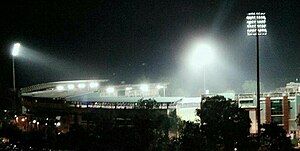
Green Park Stadium hosting the 3rd ODI between India and New Zealand.
The Green Park Stadium—formerly known as Modi Stadium—is a cricket ground in Kanpur, India. It is the home ground of the Uttar Pradesh cricket team and has played host to Ranji Trophy matches, as well as being a Test and One Day International (ODI) venue. The ground has hosted 21 Test matches, since the first one in 1952 when India played England. It has also staged 14 ODIs, the first of which was in 1986 when India lost to Sri Lanka by a margin of 17 runs. As of February 2016, no T20 International has been played at the ground.
The first century at the ground was scored by the West Indian Garfield Sobers. He made 198 during the second Test of the 1958–59 West Indies tour of India. The first Indian to score a century at the ground was Polly Umrigar, who made 147 not out against England in December 1961. West Indian Faoud Bacchus' 250, against India in February 1979, is the highest individual score by a batsman at the ground. India's Gundappa Viswanath and Mohammed Azharuddin have scored the most centuries at the venue with three each. The latter also holds the record for the highest score by an Indian at the ground. As of February 2016, 32 Test centuries have been scored at the stadium. (Full article...) -
Image 5

Khan in 2015
Irrfan Khan (7 January 1967– 29 April 2020) was an Indian actor who worked in Indian and British-American films. His on-screen debut was a minor role in Mira Nair's Salaam Bombay! in 1988. He followed this with appearances in a variety of television shows in the late 1980s to 1990s including playing ʽAbd al-Qadir Badayuni in Bharat Ek Khoj (1988), Makhdoom Mohiuddin in Kahkashan (1991), Vladimir Lenin in Lal Ghas Per Neele Ghodey (1992), a dual role in Chandrakanta (1994), and Valmiki in Jai Hanuman (1997). Khan found his television work unfulfilling and considered quitting acting.
His career experienced a turnaround with his breakthrough role as the lead in Asif Kapadia's The Warrior (2001), which won the BAFTA Award for Outstanding British Film. He followed this with critically acclaimed villainous roles in Haasil and Maqbool (both in 2003). For the former performance, where he played a devious politician, Khan received the Filmfare Award for Best Performance in a Negative Role. In 2006, Khan portrayed a first-generation Bengali immigrant in the Nair-directed film The Namesake with Tabu and a hitman in The Killer. The following year, he won the Filmfare Award for Best Supporting Actor for his performance as a 38-year-old man waiting to marry the right woman in Life in a... Metro, directed by Anurag Basu. In 2008, he received international recognition for his role as a police inspector in Danny Boyle's Slumdog Millionaire, which won the Academy Award for Best Picture. (Full article...) -
Image 6

Khan in 2017
Indian actor Aamir Khan first appeared on screen at the age of eight in a minor role in his uncle Nasir Hussain's film Yaadon Ki Baaraat (1973). In 1983, he acted in and worked as an assistant director on Paranoia, a short film directed by Aditya Bhattacharya, following which he assisted Hussain on two of his directorial ventures—Manzil Manzil (1984) and Zabardast (1985). As an adult, Khan's first acting project was a brief role in the 1984 experimental social drama Holi.
Khan's first leading role came opposite Juhi Chawla in the highly successful tragic romance Qayamat Se Qayamat Tak (1988). His performance in the film and in the thriller Raakh (1989) earned him a National Film Award – Special Mention. He went on to establish himself with roles in several lucrative films of the 1990s, including the romantic drama Dil (1990), the comedy-drama Hum Hain Rahi Pyar Ke (1993), and the romance Raja Hindustani (1996). He also played against type in the Deepa Mehta-directed Canadian-Indian co-production Earth (1998). In 1999, Khan launched a production company, Aamir Khan Productions, whose first release Lagaan (2001) was nominated for the Academy Award for Best Foreign Language Film, and earned him the National Film Award for Best Popular Film. Also in 2001, he starred alongside Saif Ali Khan and Akshaye Khanna in the acclaimed coming-of-age drama Dil Chahta Hai. Lagaan and Dil Chahta Hai are cited in the media as defining films of Hindi cinema. After a three-year hiatus, Khan portrayed the eponymous lead in Mangal Pandey: The Rising (2005), a period film that underperformed at the box office, after which he played leading roles in two top-grossing films of 2006—Fanaa and Rang De Basanti. (Full article...) -
Image 7

The Indian national cricket team at the Sydney Cricket Ground in 2012.
The India national cricket team represents India in international cricket and is a full member of the International Cricket Council with Test and One Day International (ODI) status. They first competed in international cricket in 1932, when they played against England in a three-day Test match; England won the match by 158 runs. India's first Test series as an independent country was against Australia. They secured their first Test win against England in 1952 at Madras Cricket Club Ground. , India have played 579 Test matches; they have won 178 matches, lost 178 matches, and 222 matches were drawn with one being tied. India played their first ODI match against England in 1974, but registered their first win against East Africa in 1975. , India have played 1055 ODI matches, winning 559 matches and losing 443; 9 matches were tied and 44 matches had no result. They also won the 1983 and 2011 Cricket World Cups, along with the 2002 and the 2013 ICC Champions Trophy. India played their first Twenty20 International (T20I) against South Africa in 2006, winning the match by six wickets, and won the inaugural ICC World Twenty20 in 2007. , they have played 209 T20I matches and won 140 of them; 68 were lost, with one being tied and four having no result.
India have faced ten teams in Test cricket, with their most frequent opponent being England, against whom they have played 136 matches. India have registered more wins against England than against any other team, with 35. In ODI matches, India have played against 20 teams. They have played against Sri Lanka more frequently in ODI matches, with a winning percentage of 63.37 in 99 out of 168 matches. India have defeated Sri Lanka on 99 occasions, which is their best record in ODIs. The team have played 17 countries in T20Is, and have played 31 matches with Australia. They also have recorded the most victories against Australia, Sri Lanka and the West Indies, defeating all of them in nineteen matches. (Full article...) -
Image 8

Kaif in 2016
Katrina Kaif is a British actress who predominantly appears in Bollywood films. She made her film debut in the 2003 heist film Boom, a box office bomb. She then played the titular princess in the Telugu film Malliswari (2004). Kaif had her first success in Bollywood when she appeared opposite Salman Khan in David Dhawan's romantic comedy Maine Pyaar Kyun Kiya?. The 2006 musical romance Humko Deewana Kar Gaye saw Kaif pair opposite Akshay Kumar for the first of many films, though the film was a critical and financial failure. Beginning with Namastey London, the year 2007 marked a turning point in her career when all four releases proved to be successful at the box-office. Among these were two of the highest grossing productions of the year, the comedies Partner and Welcome. following year, Kaif appeared in three films including the action comedy Singh Is Kinng.
In 2009, Kaif received a nomination for the Filmfare Award for Best Actress for her performance in Kabir Khan's terrorism drama New York. Later that year, she starred opposite Ranbir Kapoor in the comedy Ajab Prem Ki Ghazab Kahani. In 2010, Kaif portrayed the role of a politician in Prakash Jha's political thriller Raajneeti and an aspiring actress in Tees Maar Khan. While the former was a box-office hit, the latter was a critical and commercial failure. Kaif starred alongside an ensemble cast in Zoya Akhtar's comedy drama Zindagi Na Milegi Dobara (2011). She received her second Filmfare Award nomination for Best Actress for her portrayal of a runaway bride in the romantic comedy Mere Brother Ki Dulhan (2011). (Full article...) -
Image 9Vishwaroopam is a 2013 Indian spy thriller film directed by Kamal Haasan. Besides starring in the lead role with Pooja Kumar, Haasan co-produced the film with S. Chandrahaasan and Prasad V. Potluri, and co-wrote the script with Atul Tiwari. Andrea Jeremiah, Rahul Bose, Shekhar Kapur and Nassar play supporting roles in the film. The film's story revolves around Wisam Ahmed Kashmiri, a spy from India's intelligence agency Research and Analysis Wing, stopping a group of Al-Qaeda terrorists led by Omar (Bose) from triggering a dirty bomb made by scraping caesium from oncological equipment in New York City. A bilingual film, made in Tamil and Hindi (as Vishwaroop), the soundtrack and score were composed by Shankar–Ehsaan–Loy. Sanu Varghese and Mahesh Narayanan were in charge of the film's cinematography and editing respectively. Lalgudi N. Ilaiyaraaja and Boontawee 'Thor' Taweepasas were in charge of art direction while Birju Maharaj handled the choreography.
Vishwaroopam was made on a budget of ₹950 million. The film was released on 25 January 2013 worldwide except Tamil Nadu where it was banned due to protest by Islamic organisations which cited that Muslims were depicted in a negative manner. The ban on the film was lifted and it released on 7 February 2013 after a mutual agreement between Haasan and the organisations; the Hindi version was released on 1 February 2013. Both versions received generally positive reviews and were commercial successes at the box office, collectively grossing ₹2.2 billion overall. (Full article...) -
Image 10
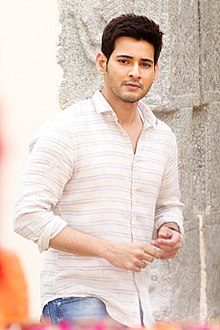
Mahesh Babu (born 9 August 1975) is an Indian actor, producer, media personality, and philanthropist who works in Telugu cinema. He is one of the highest-paid actors in Indian cinema. He first appeared in the 1979 film Needa when he was four years old. He continued to perform as a child actor in several films, most of which featured his father Krishna. Following his role as the titular protagonist in Balachandrudu (1990) while still a child, his career went on hiatus so he could concentrate on his education until taking on his first lead role as an adult in the 1999 film Rajakumarudu, for which he won the Nandi Award for Best Male Debut. Afterwards, his career stagnated until successes like Murari (2001), Okkadu (2003) and Athadu (2005) brought him fame. In 2006, he played a gangster in the Puri Jagannadh-directed action-thriller Pokiri. The film became the highest-grossing Telugu film of all time, and according to Vogue India, cemented Babu's reputation as a "superstar".
In the wake of the failures of Sainikudu (2006) and Athidhi (2007), Babu took a long-term break from cinema for personal reasons. His next project, the fantasy action film Khaleja, was released in 2010 after significant delays. In 2011, he starred in Dookudu, which became the first Telugu film to gross over ₹1 billion. Businessman (2012), his next film, was well received and became one of the year's highest grossing Telugu films at a time that was particularly harsh on other big-budget productions. The following year, Babu co-starred alongside Venkatesh in the critically and commercially acclaimed drama film Seethamma Vakitlo Sirimalle Chettu, which was considered the first Telugu multi-starrer in decades. He then featured in Sukumar's 2014 psychological thriller film 1: Nenokkadine. Although Babu's performance as a schizophrenic rock star was lauded by critics, the film itself received mixed reviews and failed to recover its budget. Aagadu, his next release that year, suffered a similar fate, despite the film's opening gross being his highest at the time. (Full article...) -
Image 11

Basu at the audio release of Creature 3D
Bipasha Basu is an Indian actress who has featured in over 50 films, predominantly in Hindi language. After a successful career as a model, she made her film debut with a supporting role in Abbas–Mustan's thriller Ajnabee (2001), which won her the Filmfare Award for Best Female Debut. Basu followed this with a role in her first Telugu cinema—the action film Takkari Donga (2002). She had her first major success with the supernatural thriller Raaz (2002), which earned Basu her first Filmfare Award for Best Actress nomination. The following year, she starred opposite John Abraham in the erotic thriller Jism, in which she played a seductive wife. She received a Filmfare Award for Best Performance in a Negative Role nomination for the film. Her roles in these films established her as a sex symbol.
Basu followed this initial success with roles in a series of commercial failures, including the thrillers Aetbaar, Rudraksh, Rakht—all in 2004—and the romance Barsaat (2005). She later featured in Prakash Jha's crime drama Apaharan (2005) and the ensemble comedy No Entry (2005). The latter emerged as a financial success, grossing ₹750 million (US$9.0 million) at the box office, and Basu's role of an escort earned her a nomination for the Best Supporting Actress at the 51st Filmfare Awards. Basu had seven film releases in 2006. Her role as an executive at a conglomerate in Madhur Bhandarkar's drama Corporate earned her another nomination for the Filmfare Award for Best Actress. She then portrayed a character based on Bianca in Vishal Bhardwaj's Omkara, an adaptation of the Shakespearean tragedy Othello. In Sanjay Gadhvi's action film Dhoom 2—her final release of the year—she played dual roles; it was the top-grossing Bollywood film of the year. In 2008, she collaborated with Abbas–Mustan for the second time for Race. Her performance as a troubled wife in Rituparno Ghosh's 2009 Bengali film Shob Charitro Kalponik was critically acclaimed. She then featured in the third installment of the Raaz series, entitled Raaz 3D (2012). Due to her frequent associations with horror films, she was labelled India's "horror queen" by the media. (Full article...) -
Image 12

Barfi! is a 2012 Indian romantic comedy-drama film written and directed by Anurag Basu and produced by UTV Motion Pictures. The film features Ranbir Kapoor, Priyanka Chopra, and Ileana D'Cruz in the lead roles, with Saurabh Shukla, Ashish Vidyarthi, and Roopa Ganguly playing supporting roles. The screenplay which incorporates a nonlinear narrative was co-written by Basu with his wife Tani. Pritam Chakraborty composed the musical and background score while Akiv Ali edited the film, with the cinematography provided by Ravi Varman. Set between 1972 and 2012, the film narrates the story of the title character from Darjeeling and his relationships with two women, Shruti and the autistic Jhilmil.
Made on a budget of approximately ₹410 million (US$4.9 million), Barfi! opened worldwide on 14 September 2012 to widespread critical acclaim. It was a major commercial success, grossing ₹1.88 billion (US$23 million) at the box office. Barfi! has received various awards and nominations, with praise for its direction, the cast's performances, cinematography, screenplay, musical score, costume and production design. As of June 2015, the film has won 70 awards. (Full article...) -
Image 13
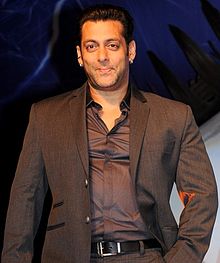
Khan at an event in 2012
Salman Khan is an Indian actor and producer, known for his work in Hindi films. He made his film debut with a brief role in Biwi Ho To Aisi (1988), before having his breakthrough with Sooraj Barjatya's blockbuster romance Maine Pyar Kiya (1989) that won him the Filmfare Award for Best Male Debut. In the early 1990s, he earned success with the action film Baaghi: A Rebel for Love (1990) and the romance Sanam Bewafa, Saajan (both 1991). His other releases during this period failed commercially, resulting in a brief setback in his career.
The success of the family drama Hum Aapke Hain Koun..! (1994) and the melodramatic action Karan Arjun (1995) revitalised Khan's career and established him in Bollywood. Also in 1994, he co-starred with Aamir Khan in the comedy movie Andaz Apna Apna, which was poorly received at that time, but later became a cult film in India. Among his three film releases of 1996 were Sanjay Leela Bhansali's critically acclaimed musical drama Khamoshi and the Raj Kanwar-directed drama Jeet. The following year, he played dual roles in David Dhawan's comedy Judwaa. In 1998, Khan featured in Sohail Khan's Pyaar Kiya To Darna Kya, and appeared briefly in the romantic drama Kuch Kuch Hota Hai, both of which ranked among the top-earning Bollywood productions of 1998. For the latter, he was awarded the Filmfare Award for Best Supporting Actor. (Full article...) -
Image 14
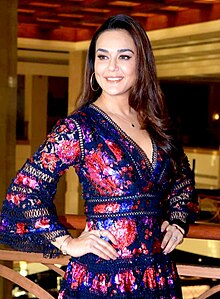
Zinta at an promotional event for Bhaiaji Superhit (2018)
Preity G Zinta is an Indian actress known for her work in Hindi films. She made her debut in 1998 with a supporting role in the drama Dil Se... Later that year, she starred in the commercially successful thriller Soldier. For the films, she won a Filmfare Award in the Best Female Debut category. In 1999, Zinta played the role of a CBI officer in the psychological thriller Sangharsh. She followed this with the role of a teenage single mother in the Kundan Shah-directed drama Kya Kehna (2000), a sleeper hit. That same year, she starred in the romance Har Dil Jo Pyar Karega, and the crime drama Mission Kashmir, the third highest grossing Bollywood film of the year.
In 2001, Zinta featured in the dramedy Dil Chahta Hai, which is cited in the media as a defining film of Hindi cinema. Later that year, she portrayed a prostitute-turned-surrogate in the romantic drama Chori Chori Chupke Chupke. Her only screen appearance of 2002 was in the box-office flop Dil Hai Tumhaara. Zinta featured in four films in 2003. Her first role of the year was opposite Sunny Deol in Anil Sharma's drama The Hero—the most expensive Bollywood film to that point. She played a negative role in the romantic drama Armaan, which saw her portray a rich, schizophrenic woman. Following this, she starred in two blockbusters—the science fiction film Koi... Mil Gaya and the drama Kal Ho Naa Ho. For the latter, she won the Filmfare Award for Best Actress. (Full article...) -
Image 15In cricket, a batsman reaches a triple century if they score 300 or more runs in a single innings. The Ranji Trophy is the premier first-class cricket championship played in India. Conducted by the Board of Control for Cricket in India, it was founded in 1934 as "The Cricket Championship of India". , a triple century has been scored on 46 occasions by 41 different batsmen in the Ranji Trophy.
The first triple century in the Ranji Trophy was scored by Maharashtra's Vijay Hazare against Baroda in the 1939–40 season. , the most recent triple century in the tournament was scored by Prithvi Shaw from Mumbai, who made 379 against Assam in the 2022–23 season. The highest score in the competition was made by B. B. Nimbalkar, who scored 443 runs not out for Maharashtra against Kathiawar in the 1948–49 season. It is the only instance of a quadruple century in the tournament. The highest number of triple centuries are scored by Ravindra Jadeja, who has reached the milestone three times while playing for Saurashtra. Jadeja is followed by V. V. S. Laxman, Cheteshwar Pujara, and Wasim Jaffer, with two triple centuries each. Tamil Nadu's Woorkeri Raman and Arjan Kripal Singh are the only two batsmen to score triple centuries in the same innings. , five batsmen have scored 290–299 runs in an innings, and three of them were not out. (Full article...) -
Image 16
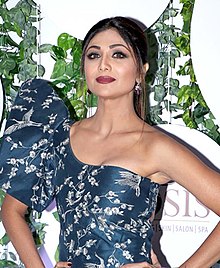
Shetty in 2018
Shilpa Shetty is an Indian actress who is primarily known for her work in Hindi films, in addition to a few Telugu, Kannada and Tamil films. Shetty made her acting debut opposite Shah Rukh Khan in the 1993 thriller Baazigar. Shetty's performance earned her two Filmfare Awards nominations for Lux New Face of the Year and Best Supporting Actress. She subsequently earned recognition with dual roles in the 1994 action-comedy Main Khiladi Tu Anari. After initial success, Shetty's films fared poorly at the box office for the next five years. Films Shetty starred in including action drama Aag, romantic drama Aao Pyaar Karen, comedy Haathkadi and Chhote Sarkar proved to be financially unsuccessful.
The 2000 romantic drama Dhadkan marked a turning point in her career, earning her several nominations in the Best Actress category at various award ceremonies. Shetty played the lead female in films such as family drama Apne, police drama Garv: Pride and Honour and musical drama Life in a... Metro. Her comic performance as an eccentric fisherwoman in 2002 action-drama release Rishtey earned her a nomination for the Filmfare Best Supporting Actress Award. Shetty became a global figure after winning the 2007 British reality television series Celebrity Big Brother, after comments made by other contestants about Shetty fell afoul of Ofcom rules and caused an international controversy over racism. (Full article...) -
Image 17

Rai Bachchan in 2023
Aishwarya Rai Bachchan is an Indian actress who has appeared in 48 films in five languages, predominantly in Hindi and Tamil. She made her acting debut in 1997 with dual role in Mani Ratnam's Tamil political drama film Iruvar, and her Bollywood debut that same year in the romantic comedy Aur Pyaar Ho Gaya opposite Bobby Deol. Rai followed it with a leading role in Jeans (1998), a high-profile Tamil film that was submitted as India's official entry to the Academy Awards. She won the Filmfare Award for Best Actress for her breakthrough role in Sanjay Leela Bhansali's romantic drama Hum Dil De Chuke Sanam and starred as a singer in the musical drama Taal (both 1999).
Rai had six film releases in 2000, including Kandukondain Kandukondain, a Tamil adaptation of Jane Austen's novel Sense and Sensibility, and Aditya Chopra's romantic drama Mohabbatein. In 2002, Rai starred opposite Shah Rukh Khan in Bhansali's period romance Devdas, an adaptation of the novel of the same name. Her performance in the top-grossing production earned her a second Best Actress award at Filmfare. In 2003, Rai played a sexually repressed widow in Rituparno Ghosh's Bengali film Chokher Bali, a sleeper hit. However, the failure of her two Hindi film releases of the year—Dil Ka Rishta and Kuch Naa Kaho—led to a setback in her Bollywood career. The following year, Rai played a character based on Elizabeth Bennet in a Bollywood-style adaptation of Austen's novel Pride and Prejudice, entitled Bride and Prejudice, a British production directed by Gurinder Chadha. Also in 2004, she reunited with Ghosh to play an unhappily married woman in the drama Raincoat. (Full article...) -
Image 18The J. C. Daniel Award is the highest award in Malayalam cinema, established by the Government of Kerala, India. It is presented annually by the Kerala State Chalachitra Academy, a non-profit institution operating under the Department of Cultural Affairs, Kerala. Instituted in 1992, the award recognizes individuals for their "outstanding contributions to Malayalam cinema". Recipients are selected by a jury appointed by the Kerala State Chalachitra Academy and the Department of Cultural Affairs. , the honourees receive a statuette, a citation, and a cash prize of ₹500,000 (US$6,000). They are honoured at the Kerala State Film Awards ceremony.
The Government of Kerala created the award to commemorate the contribution of Indian filmmaker J. C. Daniel, who is often regarded as the "father of Malayalam cinema". The J. C. Daniel Award was managed by the Department of Cultural Affairs until 1997. In 1998, the Government of Kerala constituted the Kerala State Chalachitra Academy, and since that year, the Academy has hosted the award. A cash prize of ₹50,000 (US$600) was granted with the award until 2002. In 2003, the prize money was doubled and, as part of a technical correction to update it, no award was presented that year. Actor Madhu was the first recipient of the award with the increased monetary prize of ₹100,000 (US$1,200) in 2004. Since 2016, the cash prize is ₹500,000 (US$6,000). (Full article...) -
Image 19
Preity Zinta is an Indian actress, who has received several awards for her acting in Hindi films. Her career began in 1998 with Mani Ratnam's acclaimed drama Dil Se.. and the box office hit Soldier. Both films won her the award for Best Female Debut at the 44th Filmfare Awards. Her performance in Dil Se.. also earned her a Best Supporting Actress nomination at the same ceremony, while Soldier won her three more Best Debut awards at other major ceremonies. Zinta received her first Filmfare nomination for Best Actress for her portrayal of a teenage single mother in Kya Kehna. She followed these films with several critically and commercially successful films, such as Mission Kashmir (2000) and Dil Chahta Hai (2001), and her performances in Chori Chori Chupke Chupke (2001), Dil Hai Tumhaara (2002) and Armaan (2003) were praised.
Zinta won several awards for her performance in the romantic comedy-drama Kal Ho Naa Ho, including her first and only Filmfare Award for Best Actress. She went on to star in top-grossing productions in India and abroad, including Koi... Mil Gaya (2003), Veer-Zaara (2004), Salaam Namaste (2005) and Kabhi Alvida Naa Kehna (2006), all of which earned her different nominations at major award ceremonies, which, in addition to Filmfare, include such organisations as Screen, Zee Cine, the International Indian Film Academy (IIFA), and Stardust, among others. After a relatively low phase, she started appearing in arthouse films, known in India as parallel cinema. She played her first international film role in Deepa Mehta's Canadian drama Heaven on Earth (2008, titled Videsh in India). Her portrayal in the film won her the Silver Hugo Award for Best Actress at the Chicago International Film Festival, and she was a Best Actress nominee at several award functions in Canada, including the Genie Awards by the Academy of Canadian Cinema & Television, and the Vancouver Film Critics Circle. (Full article...) -
Image 20Madras is a 2014 Indian Tamil-language drama film written and directed by Pa. Ranjith. It was produced by K. E. Gnanavel Raja under his production company, Studio Green. The film features Karthi and Catherine Tresa in the lead roles, with Kalaiyarasan, Riythvika and Rama playing supporting roles. The film's story revolves around Kaali (Karthi), an impulsive and short-tempered IT professional who lives in the Vyasarpadi area of Chennai. His friend Anbu (Kalaiyarasan) is killed in the midst of a feud between two factions of a political party over a building wall at one of the housing board apartments in the area. When Kaali hears of this, he decides to avenge Anbu's death. The soundtrack and score were composed by Santhosh Narayanan while the cinematography and editing were handled by Murali G and Praveen K. L. respectively.
Released on 26 September 2014, the film garnered generally positive reviews and was a commercial success at the box office. It was included in The Hindu's top 20 Tamil-language films of the year. The film won 24 awards from 51 nominations; its direction, screenplay, performances of the cast members, music, and cinematography have received the most attention from award groups. (Full article...) -
Image 21

Rohit Sharma and MS Dhoni both hold the record of most titles as captain in Indian Premier League with 5 titles each.
In cricket, a captain is a player who leads the team and has additional roles and responsibilities. The Indian Premier League (IPL) is a professional league for Twenty20 cricket in India, which has been held annually since its first edition in 2008. In the 17 seasons played, 70 players have captained their team in at least one match.
Mumbai Indians' Rohit Sharma has won 6 titles as a player and 5 as a captain making him the joint most successful player (along with Ambati Rayudu) and joint most successful captain in IPL history along with Chennai Super Kings's MS Dhoni. With the highest win–loss percentage among successful captains who have captained over 44 matches, MS Dhoni is the captain and player who has played most number of finals and qualified for most times in the playoffs. He has played 226 matches and won the most number of matches as a captain with 133, and has also lost the most matches playing as a captain with 91, where as Rohit Sharma has a second place with 5 titles. Mahela Jayawardene, Kumar Sangakkara, and Steven Smith are the only players to captain three teams: Jayawardene has captained Delhi Daredevils, Kings XI Punjab and Kochi Tuskers Kerala, Sangakkara has captained Kings XI Punjab, Deccan Chargers and Sunrisers Hyderabad, and Smith has captained Pune Warriors India, Rajasthan Royals, Rising Pune Supergiants. James Hopes of the Daredevils has captained the most matches without registering a win; he led his team in three matches, two of which were lost and one ended with no result. (Full article...) -
Image 22

The Victoria Cross
The Victoria Cross (VC) is a military decoration bestowed on members of the British or Commonwealth armed forces for acts of valour or gallantry performed in the face of the enemy. In the British honours system and those of many Commonwealth nations it is the highest award a soldier can receive for actions in combat. It was established in 1856 and since then has been awarded 1,356 times, including to three recipients who were awarded the VC twice.
The British Army's Brigade of Gurkhas, units composed of Nepalese soldiers—although originally led by British officers—has been a part of the army since 1815. When raised, it originally focused on conflicts in the Far East, but the transfer of Hong Kong from British to Chinese hands necessitated that the brigade move its base to the UK. A battalion is still maintained in Brunei and as at 2016, units serve in Afghanistan. (Full article...) -
Image 23
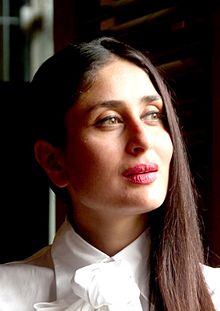
Kapoor Khan at an event for Bajrangi Bhaijaan in 2015
Kareena Kapoor Khan is an Indian actress who has appeared in more than 60 Hindi films. She made her acting debut opposite Abhishek Bachchan in the 2000 drama Refugee, for which she won the Filmfare Award for Best Female Debut. The following year, she appeared in five films, including the romance Mujhe Kucch Kehna Hai, the thriller Ajnabee (2001), and the ensemble melodrama Kabhi Khushi Kabhie Gham.... The latter emerged as the highest-grossing Bollywood film in overseas to that point, and the success of these films established her in Bollywood. This success was followed by repetitive roles in a series of commercial failures.
In 2004, Kapoor portrayed a prostitute in the drama Chameli (2004) and Fida (2004), which proved to be a turning point in her career, earning her a Filmfare Special Award. That same year, she played a Muslim woman affected by the 2002 Gujarat riots in Govind Nihalani's political drama Dev, and two years later, she played the Desdemona character in Omkara (2006), an adaptation of William Shakespeare's tragedy Othello from director Vishal Bhardwaj. She won two Filmfare Critics Award for Best Actress for these films. In 2007, Kapoor played a loquacious Sikh girl in Jab We Met, a commercially successful romantic comedy co-starring Shahid Kapoor, for which she won the Filmfare Award for Best Actress. (Full article...) -
Image 24
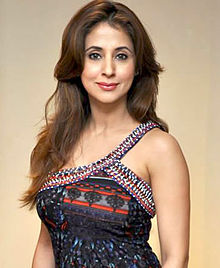
Matondkar in 2010
Urmila Matondkar is an Indian actress known for her work in Hindi films. She has appeared in over 60 films. She has been praised by the critics for her acting and dancing skills. She made her screen debut as a child artist in B.R. Chopra's Karm (1977), and later appeared in Shekhar Kapur's critically acclaimed Masoom (1983). After making her debut as the heroine in 1989 Malayalam thriller Chanakyan, Urmila began a full-time acting career, with a leading role in the 1991 action Narsimha. She rose to prominence with Ram Gopal Varma's blockbuster Rangeela (1995). Her portrayal of an aspiring actress, Mili Joshi, opposite Aamir Khan received praise from critics, and garnered her first nomination for the Filmfare Award for Best Actress.
In 1997, Urmila received a nomination for Filmfare Award for Best Supporting Actress for her performance in the drama Judaai. The following year, she starred in the crime drama Satya, which has been cited as one of the greatest films of Indian cinema, for which she received another nomination for Best Actress. The same year, her dance performance in the item number "Chamma Chamma" from China Gate won her rave reviews. In 1999, she received praise for playing a psychopath in the thriller Kaun and a reserved girl in the romantic comedy Khoobsurat, a box office success. Her other four releases of the year including Jaanam Samjha Karo, and Hum Tum Pe Marte Hain were commercial failures. She played an obsessive lover in the 2001 romantic drama Pyaar Tune Kya Kiya, which earned her a nomination for the Filmfare Award for Best Performance in a Negative Role. (Full article...)
 Good article – show another
Good article – show another
-
Image 1Bengal tiger in Corbett National Park
Jim Corbett National Park is a national park in India located in the Nainital district of Uttarakhand state. The first national park in India, it was established in 1936 during the British Raj and named Hailey National Park after William Malcolm Hailey, a governor of the United Provinces in which it was then located. In 1956, nearly a decade after India's independence, it was renamed Corbett National Park after the hunter and naturalist Jim Corbett, who had played a leading role in its establishment and had died the year before. The park was the first to come under the Project Tiger initiative.
Corbett National Park comprises 520.8 km2 (201.1 sq mi) area of hills, riverine belts, marshy depressions, grasslands and a large lake. The elevation ranges from 1,300 to 4,000 ft (400 to 1,220 m). Winter nights are cold but the days are bright and sunny. It rains from July to September. The park has sub-Himalayan belt geographical and ecological characteristics. Dense moist deciduous forest mainly consists of Shorea robusta (the sal tree), haldu, peepal, rohini and mango trees. Forest covers almost 73 per cent of the park, while 10 per cent of the area consists of grasslands. It houses around 110 tree species, 50 species of mammals, 580 bird species and 25 reptile species. (Full article...) -
Image 2Businessman is a 2012 Indian Telugu-language action crime film directed and written by Puri Jagannadh and produced by R. R. Venkat under the banner R. R. Movie Makers. It is based from a concept by Ram Gopal Varma and stars an ensemble cast featuring Mahesh Babu, Kajal Aggarwal, Prakash Raj, Nassar, Sayaji Shinde, Raza Murad, Subbaraju and Brahmaji. In the film, Vijay Surya arrives at Mumbai with aspirations to rule the city due to his grudge against the corrupt system in the country, but begins to face violent challenges from the cops and his enemies.
S. Thaman composed the music, while Shyam K. Naidu and M. S. Rajashekhar Reddy (S. R. Shekhar) handled the cinematography and editing. The film was made with a budget of ₹40 crore and was launched formally on 15 August 2011 in Hyderabad. Principal photography began on 2 September 2011 and was shot in Hyderabad, Mumbai and Goa. A few song sequences were shot in Bangkok. Filming ended on 10 December 2011 in 74 working days, making as one of the shortest periods in which a Telugu film has been shot. (Full article...) -
Image 3

The 1970 North Indian Ocean cyclone season had no bounds, but tropical cyclones in the North Indian Ocean tend to form between April and December, with peaks in May and November. The 1970 season saw a total of seven cyclonic storms, of which three developed into severe cyclonic storms. The Bay of Bengal was more active than the Arabian Sea during 1970, with all of the three severe cyclonic storms in the season forming there. Unusually, none of the storms in the Arabian Sea made landfall this year. The most significant storm of the season was the Bhola cyclone, which formed in the Bay of Bengal and hit Bangladesh on November 12. The storm killed at least 500,000, making it the deadliest tropical cyclone in recorded history. The season was also the deadliest tropical cyclone season globally, with 500,805 fatalities, mostly due to the aforementioned Bhola cyclone. (Full article...) -
Image 4Devdas is a 2002 Indian Hindi-language period romantic drama film directed by Sanjay Leela Bhansali and produced by Bharat Shah under his banner, Mega Bollywood. It stars Shah Rukh Khan, Aishwarya Rai and Madhuri Dixit in lead roles, with Jackie Shroff, Kirron Kher, Smita Jaykar, and Vijayendra Ghatge in supporting roles. Based on the 1917 novel of the same name by Sarat Chandra Chattopadhyay, the film narrates the story of Devdas Mukherjee (Khan), a wealthy law graduate who returns from London to marry his childhood friend, Parvati "Paro" (Rai). However, the rejection of their marriage by his own family sparks his descent into alcoholism, ultimately leading to his emotional deterioration and him seeking refuge with the golden-hearted courtesan Chandramukhi (Dixit).
Bhansali was inspired to remake the novel into a film after reading it for a second time, and announced the project in November 1999. The screenplay was written by him and Prakash Ranjit Kapadia, who also wrote the dialogue. Nitin Chandrakant Desai built the sets between August 2000 and May 2001, spending ₹200 million (US$4.12 million). Along with Bhansali and other crews, he did extensive research on Calcuttan building design from the period of the British Raj. Principal photography was handled by Binod Pradhan from November 2000 to April 2002, taking place in Bikaner, Film City, and Filmistan. While Ismail Darbar and Birju Maharaj composed the soundtrack, Monty Sharma composed the background score. (Full article...) -
Image 5
Morya Gosavi or Moraya Gosavi (Morayā Gosāvi) alias Moroba Gosavi was a prominent saint of the Hindu Ganapatya sect, which considers Ganesha as the Supreme God. Morya Gosavi is considered the chief spiritual progenitor of the Ganapatyas and has been described as the "most famous devotee" of Ganesha.
The lifetime of Morya Gosavi is speculated between the 13th to 17th century. Numerous legends recall his life. Morya became devoted to Ganesha when he started visiting the Morgaon temple of Ganesha. It is believed that due to the hindrance in Morya's services to the god in the popular Ganesha shrine, Ganesha told Morya that he would appear in Chinchwad for Morya to worship, so Morya moved from Morgaon to Chinchwad, where Morya built a Ganesha temple. Consequently, Morya took sanjeevan samadhi by burying himself alive in his tomb. (Full article...) -
Image 6
Varahi (Sanskrit: वाराही, IAST:Vārāhī) is one of the Matrikas, a group of seven mother goddesses in the Hindu religion. Bearing the head of a sow, Varahi is the shakti (feminine energy) of Varaha, the boar avatar of the god Vishnu. In Nepal, she is called Barahi. In Rajasthan and Gujarat, she is venerated as Dandini.
The Buddhist goddesses Vajravārāhī and Marichi have their origins in the legend of Hindu goddess Varahi. Varahi is more commonly venerated in the sect of the Goddess-oriented Shaktism, but also in Shaivism (devotees of Shiva) and Vaishnavism (devotees of Vishnu). She is usually worshipped at night, using secretive Vamamarga Tantric practices. (Full article...) -
Image 7
Somnath Sharma, PVC (31 January 1923 – 3 November 1947), was an Indian military officer and the first recipient of India's highest military decoration, Param Vir Chakra (PVC), which he was awarded posthumously.
Sharma was commissioned into the 8th Battalion, 19th Hyderabad Regiment, in 1942. He served in Burma during the Arakan Campaign in World War II, for which he was mentioned in despatches. Fighting in the Indo-Pakistani War of 1947-1948, Somnath Sharma was killed in action on 3 November 1947 while repulsing Pakistani infiltrators near Srinagar Airport. For his gallantry and sacrifice during the Battle of Badgam, he was posthumously awarded the Param Vir Chakra. (Full article...) -
Image 8
Śāriputra (Sanskrit: शारिपुत्र; Tibetan: ཤཱ་རིའི་བུ་, Pali: Sāriputta, lit. "the son of Śāri", born Upatiṣya, Pali: Upatissa) was one of the top disciples of the Buddha. He is considered the first of the Buddha's two chief male disciples, together with Maudgalyāyana (Pali: Moggallāna). Śāriputra had a key leadership role in the ministry of the Buddha and is considered in many Buddhist schools to have been important in the development of the Buddhist Abhidharma. He frequently appears in Mahayana sutras, and in some sutras, is used as a counterpoint to represent the Hinayana school of Buddhism.
Historians believe Śāriputra was born in the ancient Indian kingdom of Magadha around the 6th or 5th century BCE. Buddhist texts relate that Śāriputra and Maudgalyāyana were childhood friends who became spiritual wanderers in their youth. After having searched for spiritual truth with other contemporary teachers, they came into contact with the teachings of the Buddha and ordained as monks under him, after which the Buddha declared the friends his two chief disciples. Śāriputra was said to have attained enlightenment as an arhat two weeks after ordination. As chief disciple Śāriputra assumed a leadership role in the Sangha, doing tasks like looking after monks, assigning them objects of meditation, and clarifying points of doctrine. He was the first disciple the Buddha allowed to ordain other monks. Śāriputra died shortly before the Buddha in his hometown and was cremated. According to Buddhist texts, his relics were then enshrined at Jetavana Monastery. Archaeological findings from the 1800s suggest his relics may have been redistributed across the Indian subcontinent by subsequent kings. (Full article...) -
Image 9
The 1990 Andhra Pradesh cyclone was the worst disaster to affect Southern India since the 1977 Andhra Pradesh cyclone. The system was first noted as a depression on 4 May 1990, while it was located over the Bay of Bengal about 600 km (375 mi) to the southeast of Chennai, India. During the next day the depression intensified into a cyclonic storm and started to intensify rapidly, becoming a super cyclonic storm early on 8 May. The cyclone weakened slightly before it made landfall on India about 300 km (190 mi) to the north of Madras in the Andhra Pradesh state as a very severe cyclonic storm with winds of 165 km/h (105 mph). While over land the cyclone gradually dissipated. The cyclone had a severe impact on India, with over 967 people reported to have been killed. Over 100,000 animals also died in the cyclone with the total cost of damages to crops estimated at over $600 million (1990 USD). (Full article...) -
Image 10Dor (Hindi pronunciation: [ɖoːɾ]; transl. String) is a 2006 Indian Hindi-language drama film written and directed by Nagesh Kukunoor and features Ayesha Takia, Gul Panag and Shreyas Talpade as the lead actors. The film is an official adaptation of the Malayalam film, Perumazhakkalam (2004) and was well received by the critics after its release on 22 September 2006.
Dor, which was produced by Elahe Hiptoola, had cinematography by Sudeep Chatterjee and editing by Sanjib Datta. For a film that had Hindi as the predominant language with a sporadic use of Urdu, Salim–Sulaiman composed the background score. (Full article...) -
Image 11

The Ross Island Prison Headquarters, 1872
Ross Island Penal Colony was a convict settlement that was established in 1858 in the remote Andaman Islands by the British colonial government in India, primarily to jail a large number of prisoners from the Indian Rebellion of 1857, also known as the Indian Mutiny. With the establishment of the penal colony at Ross Island, the British administration made it the administrative headquarters for the entire group of Andaman and Nicobar Islands and built bungalows and other facilities on the site. This colony was meant as "manageable models of colonial governance and rehabilitation". The Chief Commissioner's residence was located at the highest point on the island. Over time, several other islands including Chatham and Viper were used for the penal colony.
The penal colony became infamous as "Kalapani" or "black water" for the brutalities inflicted by the British authorities on the political prisoners from India, and most of whom had died by 1860 due to illness and torture suffered during the initial stages of the clearance of the forest to establish the colony. In later years the colony experimented for a short time with civilizing the indigenous people of Andamans. The penal colony was used as an experimental station for various methods of torture and medical tests During World War II, the island was invaded by the Japanese army, forcing the British to evacuate. The administrative buildings were destroyed but the penal colony remained. After the Allied forces reoccupied the island the penal colony was disbanded on 7 October 1945. (Full article...) -
Image 12
Barrackpore Trunk Road, commonly known as BT Road, is six-laned trunk road in Kolkata metropolitan area, West Bengal, India. It connects Kolkata with its suburb Barrackpore. Built in 1775, it is the oldest metalled road and one of the busiest roads in the country. The 18.1 km (11.2 mi) long road is a part of both State Highway 1 and State Highway 2.
Barrackpore Trunk Road has multiple institutes and other landmarks along it, including the Indian Statistical Institute and Rabindra Bharati University. Once the areas around the road were industrial zones, but gradually, residential areas sprawled and replaced the industries. The city's 160-year-old water supply pipeline runs under the road. An elevated metro line was planned in 2010–2011 over the road from Baranagar to Barrackpore. BT Road has a major intersection at Dunlop. (Full article...) -
Image 13Anjaana Anjaani (transl. "Strangers") is a 2010 Indian Hindi-language romantic comedy-drama film directed by Siddharth Anand and produced by Sajid Nadiadwala. The film stars Priyanka Chopra and Ranbir Kapoor as two suicidal strangers who meet and make a pact to commit suicide in 20 days on New Year's Eve. In the interim, the couple fulfils their personal wishes and eventually falls in love. The soundtrack of the film, composed by Vishal–Shekhar and lyrics by various artists including the duo themselves, received widespread critical acclaim and was a major commercial success. It is inspired by the Telugu film Itlu Sravani Subramanyam (2001). The film was promoted with the tag-line "All The Greatest Love Stories Are Between Strangers."
Wanting to make an unusual romance film, Anand struggled to find unconventional ideas while he was writing. His wife, Mamta, then came up with the core narrative of the film, which excited him and changed his perspective. Anand approached novelist Advaita Kala who developed the story into a feature-length script, and later co-wrote the screenplay with him. Principal photography was done entirely in New York City, Las Vegas and San Francisco. (Full article...) -
Image 14Alexander in the Alexander Mosaic
Alexander III of Macedon (Ancient Greek: Ἀλέξανδρος, romanized: Alexandros; 20/21 July 356 BC – 10/11 June 323 BC), most commonly known as Alexander the Great, was a king of the ancient Greek kingdom of Macedon. He succeeded his father Philip II to the throne in 336 BC at the age of 20 and spent most of his ruling years conducting a lengthy military campaign throughout Western Asia, Central Asia, parts of South Asia, and Egypt. By the age of 30, he had created one of the largest empires in history, stretching from Greece to northwestern India. He was undefeated in battle and is widely considered to be one of history's greatest and most successful military commanders.
Until the age of 16, Alexander was tutored by Aristotle. In 335 BC, shortly after his assumption of kingship over Macedon, he campaigned in the Balkans and reasserted control over Thrace and parts of Illyria before marching on the city of Thebes, which was subsequently destroyed in battle. Alexander then led the League of Corinth, and used his authority to launch the pan-Hellenic project envisaged by his father, assuming leadership over all Greeks in their conquest of Persia. (Full article...) -
Image 15Hindi Medium (Hindi: हिंदी मीडियम) is a 2017 Indian Hindi-language comedy-drama film written and directed by Saket Chaudhary, and produced by Dinesh Vijan and Bhushan Kumar under their respective banners Maddock Films and T-Series. It stars Irrfan Khan, Saba Qamar, Dishita Sehgal, Deepak Dobriyal and Amrita Singh. Set in Delhi, the plot centres on a couple's struggle to get their daughter admitted to a prestigious English-medium school in order to rise in society.
The idea for the film was created by Chaudhary and his co-writer Zeenat Lakhani during the development of his previous film Shaadi Ke Side Effects (2014). It was shot in Chandni Chowk, Anand Lok, Karol Bagh, and Sangam Vihar. The film's soundtrack album was composed by the duo Sachin–Jigar, with lyrics by Priya Saraiya and Kumaar. The score was composed by Amar Mohile. Cinematography was handled by Laxman Utekar, and A. Sreekar Prasad edited the film. (Full article...) -
Image 16
The "Kolkata class" (Project 15A) are a class of stealth guided-missile destroyers constructed for the Indian Navy. The class comprises three ships – Kolkata, Kochi and Chennai, all of which were built by Mazagon Dock Limited (MDL) in India, and are the largest destroyers to be operated by the Indian Navy. Due to delays in construction and sea trials, the initial commissioning date of the first ship of the class was pushed back from 2010 to 2014.
The destroyers are a follow-on of the Project 15 Delhi-class destroyers, but are considerably more capable due to major improvements in the design, the addition of substantial land-attack capabilities, the fitting-out of modern sensors and weapons systems, and the expanded use of net-centric capability such as Cooperative Engagement Capability. (Full article...) -
Image 17

Zakir Husain Khan (8 February 1897 – 3 May 1969) was an Indian educationist and politician who served as the third president of India from 13 May 1967 until his death on 3 May 1969.
Born in Hyderabad in an Afridi Pashtun family, Husain completed his schooling in Etawah and went on to study at the Muhammadan Anglo-Oriental College, Aligarh and the University of Berlin from where he obtained a doctoral degree in economics. A close associate of Mahatma Gandhi, Husain was a founding member of the Jamia Millia Islamia which was established as an independent national university in response to the Non-cooperation movement. He served as the university's vice-chancellor from 1926 to 1948. In 1937, Husain chaired the Basic National Education Committee which framed a new educational policy known as Nai Talim which emphasized free and compulsory education in the first language. He was opposed to the policy of separate electorates for Muslims and, in 1946, the Muslim League under Muhammad Ali Jinnah vetoed a proposal by the Indian National Congress to include Husain in the Interim Government of India. (Full article...) -
Image 18Kapoor at the 2017 International Indian Film Academy Awards
Shahid Kapoor (pronounced [ʃaːɦɪd̪ kəˈpuːr]; born 25 February 1981) is an Indian actor who appears in Hindi films. Initially recognised for portraying romantic roles, he has since taken on parts in action films and thrillers, and is the recipient of several awards, including three Filmfare Awards.
The son of actors Pankaj Kapur and Neelima Azeem, Kapoor trained as a dancer at Shiamak Davar's academy. He appeared as a background dancer in a few films of the 1990s, and featured in music videos and television commercials. He made his film debut in 2003 with a leading role in the romantic comedy Ishq Vishk, a sleeper hit for which he won the Filmfare Award for Best Male Debut. He followed it with roles in several commercial failures before starring in Sooraj Barjatya's top-grossing family drama Vivah (2006). (Full article...) -
Thozha (transl. Friend) is a 2016 Indian comedy-drama film directed by Vamshi Paidipally, and produced by PVP Cinema. The film is produced in the Telugu film industry, and is shot simultaneously in Telugu and Tamil languages. The film stars Nagarjuna, Karthi and Tamannaah Bhatia while Prakash Raj, Ali, Vivek, Jayasudha, Kalpana and Tanikella Bharani playing supporting roles. Karthi debuts in Telugu cinema through this film. The film focuses on the lives of Vikramaditya, a quadriplegic billionaire, and Seenu, his ex-convict caretaker. Their realisation of the primacy of life and relationships over money and disability forms the major part of its story.
A remake of Éric Toledano and Olivier Nakache's French film The Intouchables (2011). The remake rights for The Intouchables were earlier acquired by Karan Johar and Guneet Monga in May 2014, who authorised PVP Cinema to produce the adaptation of this film in regional languages, postponing their previous plans; thus making Oopiri its first remake. Principal photography began in March 2015 and ended by February 2016 taking place in Chennai, Hyderabad, Paris, Belgrade and Novi Sad. Gopi Sundar composed the film's soundtrack and score, and P. S. Vinod handled the cinematography. Madhu and Praveen K. L. edited the Telugu and Tamil versions, respectively. (Full article...)
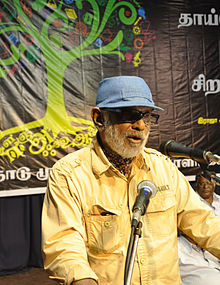
Balanathan Benjamin Mahendran (19 May 1939 – 13 February 2014), commonly known as Balu Mahendra, cinematographer, director, screenwriter and film editor who worked in various Indian film industries, primarily in Tamil and Malayalam cinema. Born in Sri Lanka, Mahendran developed a passion for photography and literature at a young age, after witnessing the shoot of David Lean's The Bridge on the River Kwai (1957) during a school trip in Sri Lanka, he was drawn towards filmmaking. After graduation he joined as an Aerial photographer in the Sri Lankan Government. In 1966, he moved to India and gained admission to the Film and Television Institute of India (FTII) to pursue a course in motion picture photography. Upon completion of his diploma, he entered Malayalam cinema as a cinematographer in the early 1970s.
After working in over 20 films as a cinematographer, Mahendra made his directorial debut in 1977 with the Kannada film Kokila. Since then, he directed over 20 films in a span of 36 years. Along with Bharathiraja and Mahendran, he is regarded as a trendsetter in Tamil cinema. Widely regarded as an auteur, Mahendra usually scripted and edited his films apart from shooting them. He was the recipient of six National Film Awards (including two for Best Cinematography), five Filmfare Awards South and several state government awards. During the tail end of his career, he established a film school in Chennai, which offers courses in cinematography, direction and acting. Following a brief phase of poor health, Mahendra died of cardiac arrest in February 2014. (Full article...)
Zafar conceived the film, which was the last to be narrated to founder Yash Chopra, as an amalgam of stories he had heard from his father as a child about the effects of war-caused immigration and the Mafia Raj's illegal marketing of coal. He wrote the film as a tale of the consequences of the struggle of two outlaws against the system, using his father's stories as a backdrop for the characters. Principal photography began in Mumbai in December 2012 before moving to Kolkata, where extensive filming was done. The soundtrack was composed by Sohail Sen, and the lyrics were penned by Irshad Kamil, while Julius Packiam composed the background score, taking over Sen's duties from Zafar's debut, Mere Brother Ki Dulhan, eventually becoming a regular collaborator. (Full article...)
Huma Saleem Qureshi (pronounced [ˈɦʊmaː səˈliːm qʊˈɾɛːʃiː]; born 28 July 1986) is an Indian actress who primarily appears in Hindi-language films. Her accolades include a Filmfare OTT Award along with nominations for three Filmfare Awards.
Qureshi studied history in Delhi while she worked as a theatre actor and model. She then moved to Mumbai and signed a two-year contract with Hindustan Unilever to appear in television commercials. During the shoot for a Samsung mobile commercial, Anurag Kashyap noticed her acting ability and signed her for a three-film deal with his company, marking her film debut with a supporting role in the two-part 2012 crime drama Gangs of Wasseypur. Her performance in the film earned her a nomination for the Filmfare Award for Best Supporting Actress. (Full article...)
The film marked Prasad's return to film production after an eight-year hiatus. P. G. Vinda was the film's director of photography. Mani Sharma composed the soundtrack and score; Marthand K. Venkatesh edited the film. Principal photography commenced in November 2015 and lasted until April 2016. Except for a schedule in Kodaikanal, the majority of the film's portions were shot in and around Hyderabad. (Full article...)
Tripathi started writing The Secret of the Nagas while the first part of the trilogy was being released. He relied on his knowledge of geography and history to expand the locations visited in the story. The book was released on 12 August 2011, and was published by Westland Press. Before its release, the author confessed that many revelations would be present in the book, including the true nature of many characters. Two theatrical trailers were created for showing in multiplex cinema halls, as Tripathi believed that the film-going audience also reads his books, and that would create publicity. (Full article...)
News
- 8 July 2024 – India–Russia relations
- Indian Prime Minister Narendra Modi visits Moscow, Russia, for the first time since the start of the Russian invasion of Ukraine. (Al Jazeera)
- 3 July 2024 – 2024 India-Bangladesh floods
- At least sixteen people are killed and more than 300,000 others are displaced by floods and landslides in Assam and Arunachal Pradesh, India. (The Independent)
- 2 July 2024 – 2024 Uttar Pradesh stampede
- 123 people are killed in a stampede at a religious gathering in Hathras, Uttar Pradesh, India. (India Today) (Hindustan Times)
- 29 June 2024 –
- Five Indian soldiers are killed in Ladakh, India, after their tank sinks in abruptly increased water levels in the Shyok River during a military exercise. (AP)
- 28 June 2024 –
- A roof at the Indira Gandhi International Airport in New Delhi, India, collapses amid heavy rains killing one person, injuring eight others, and leading to the cancellation of some domestic flights. (Reuters)
Did you know...
- ... that Cusrow Baug in Mumbai had only a few tenants in the 1950s even at a low rent of 40 rupees per month?
- ... that Indian philanthropist and business executive T. Mohandas Pai has been called the "architect of modern Manipal"?
- ... that police in Indianola, Mississippi, shot an unarmed 11-year-old African-American boy after responding to his 9-1-1 call for help at his home?
- ... that Al-Wishah fi Fawa'id al-Nikah, a 15th-century Islamic sex manual by Egyptian writer Al-Suyuti, was based on both traditional hadith literature and material influenced by Indian erotology?
- ... that Zail Singh was the first Sikh and the first person from a backward caste to become President of India?
- ... that Indian politician Pushpaben Mehta was the first speaker of the Saurashtra Legislative Assembly?
Topics related to India
Timeline of Indian history, Indus Valley Civilisation, Dholavira, Science and technology in ancient India, Meluhha, Aryan invasion theory, Out of India theory, Greek conquests in India, Indian maritime history, Maurya Empire, Ashoka, Shunga Empire, Hoysala Empire, Vijayanagara, Satavahana dynasty, Indo-Greek Kingdom, Indo-Scythians, Indo-Parthian Kingdom, Kushan Empire, Western Satraps, Gupta Empire, Chola dynasty, Pala Empire, Islamic incursions in India, Mughal Empire, Maratha Empire, British Raj, East India Company, Governor-General, Viceroy, War of Independence, 1857, Indian independence movement, Indian National Army, Azad Hind, Quit India Movement, Partition of India, History of Republic of India, Non-Aligned Movement, Sino-Indian War, Indo-Pakistani War of 1947–1948, Indo-Pakistani War of 1965, Indo-Pakistani War of 1971, Kargil War, 2001–02 India–Pakistan standoff, Military, Demographic
Law, Hindu law, Constitution, Political parties (Indian National Congress, Bharatiya Janata Party), Foreign relations, Elections, Political divisions, Reservation in India
Government agencies, Legislative branch (Lok Sabha, Rajya Sabha) Executive branch (President & Vice President, Prime Minister & Deputy Prime Minister, Cabinet Ministers, Cabinet Secretary, Election Commission, Foreign Minister; Law enforcement: CBI, CID, Intelligence: IB, RAW), Directorate General of Income Tax Investigation Judicial branch (Supreme Court), Armed Forces (Army, Navy, Air Force, Border Security Force, Coast Guard)
Himalayas, Western Ghats, Eastern Ghats, Indo-Gangetic Plain, Deccan Plateau, Thar Desert, Ganges, Rann of Kutch, Brahmaputra River, Northeast India; Mountains, Valleys, Islands, Rivers; States and union territories, Cities, Districts, Regions, Fauna, Flora
Rupee, Bombay Stock Exchange, National Stock Exchange, Standard of living, Companies, Reserve Bank of India, Energy policy (Solar, Wind, Nuclear), Tourism, Transport (Expressways, Rail transport, Auto rickshaw),
Languages, Standard of living, Religion
Music (Carnatic, Hindustani, Indi-pop), Dance, Languages, Literature, Architecture, Film & TV, Cuisine, Holidays, Folklore, Education, Media, Indian martial arts
Indian Council of Agricultural Research (ICAR), Indian Institute of Astrophysics, National Centre for Software Technology, AIIMS, IISc, IIT, NIT, BITS-Pilani, INRegistry, Indian numbering system, Indian Space Research Organisation, National Internet Exchange of India, ICRISAT, International Institute of Information Technology, Hyderabad
Indian English, Indian nationality law, Numbering system, Indian Space Research Organisation, Telecommunications, National Highways Development Project, Flag, Vehicle registration plates, Indian nationalism, Metrication in India
Categories
Related portals
Religions in India
Indian Subcontinent
Other countries
Wikipedias in Indian languages
- অসমীয়া (Assamese)
- বাংলা (Bengali)
- भोजपुरी (Bhojpuri)
- বিষ্ণুপ্রিয়া মণিপুরী (Bishnupriya Manipuri)
- गोंयची कोंकणी / Gõychi Konknni (Konkani)
- ગુજરાતી (Gujarati)
- हिन्दी (Hindi)
- ಕನ್ನಡ (Kannada)
- कॉशुर/كشميري (Kashmiri)
- मैथिली (Maithili)
- മലയാളം (Malayalam)
- मराठी (Marathi)
- नेपाली (Nepali)
- नेपाल भाषा
- (Newari)
- ଓଡ଼ିଆ (Odiya)
- ਪੰਜਾਬੀ (Punjabi)
- पालि (Pali)
- संस्कृत (Sanskrit)
- ᱥᱟᱱᱛᱟᱲᱤ (Santali)
- سنڌي (Sindhi)
- தமிழ் (Tamil)
- తెలుగు (Telugu)
- ತುಳು (Tulu)
- اردو (Urdu)
Associated Wikimedia
The following Wikimedia Foundation sister projects provide more on this subject:
-
Commons
Free media repository -
Wikibooks
Free textbooks and manuals -
Wikidata
Free knowledge base -
Wikinews
Free-content news -
Wikiquote
Collection of quotations -
Wikisource
Free-content library -
Wikiversity
Free learning tools -
Wikivoyage
Free travel guide -
Wiktionary
Dictionary and thesaurus
- Pages with Hindustani IPA
- Pages using the Phonos extension
- Pages with Tamil IPA
- Pages including recorded pronunciations
- Pages with Hindi IPA
- Pages with Kannada IPA
- Portals with triaged subpages from June 2018
- All portals with triaged subpages
- Portals with no named maintainer
- Automated article-slideshow portals with 51–100 articles in article list
- Automated article-slideshow portals with 101–200 articles in article list
- Automated article-slideshow portals with 501–1000 articles in article list
- Wikipedia move-protected portals
- Redirect targets of redirected portals with existing subpages







